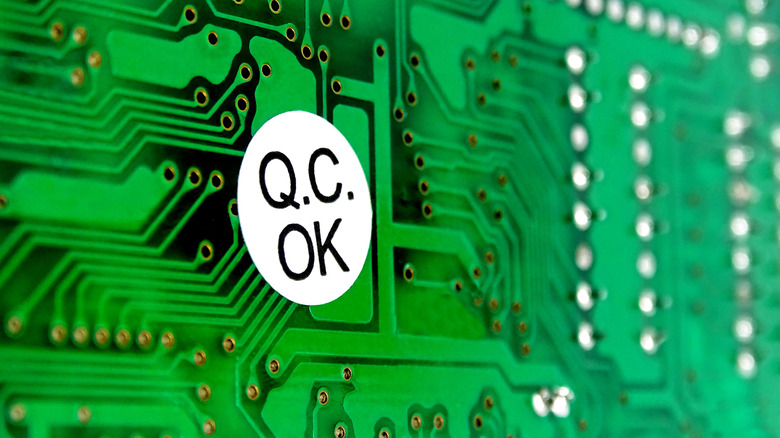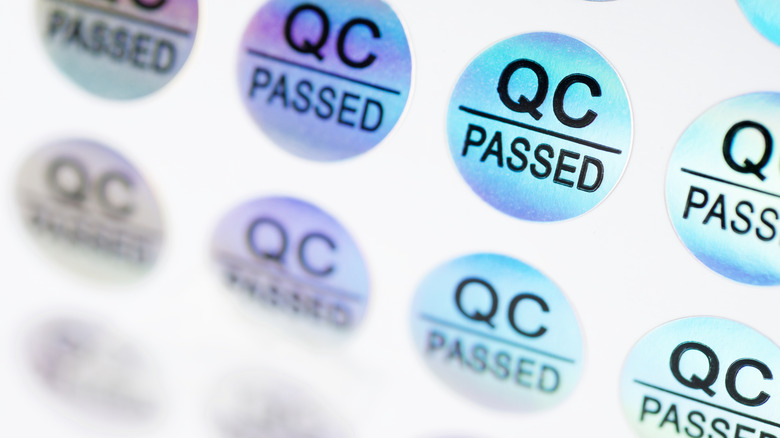Why Electronics Have Those Colored QC Stickers (And What They Mean)
Have you ever been browsing the electronics aisle, trying to choose a new laptop, phone, or gadget, when you noticed a strange sticker on your selected item? Don't worry, this doesn't mean the product was pulled from the rejects bin. In fact, labels play an integral role in ensuring that electronics meet safety, environmental, and quality standards. Both federal and state regulators require manufacturers to label their products after passing mandated testing procedures. These procedures are critical to preventing everything from embarrassing tech recalls to health and environmental issues. In January 2025, the White House announced the establishment of its Cyber Trust Mark, a much-discussed new badge certifying the cybersecurity standards for interconnected devices.
This is especially common in the electronics industry, where consumers often find a series of stickers when purchasing a new phone or laptop. One common instance is the FCC mark, which the Federal Communications Commission requires for any radio-emitting device to certify that it does not electromagnetically affect other devices. Residents of California may be familiar with the California Prop 65 sticker, which warns buyers of any potentially carcinogenic materials in a product.
So, what are the QC stickers, and what do they mean? Well, the simple answer is that QC is an abbreviation for quality control, and the sticker is placed on a product after it has undergone substantial testing procedures.
A guide to quality control
Quality control tests are critical to the manufacturing process, ensuring that companies avoid major tech malfunctions. Systematic quality control tests predate the industrial processes we associate them with, hearkening back to ancient civilizations in Babylon, Egypt, and China. From a modern perspective, industrial standards began following Frederick Winslow Taylor's revolutionary scientific management system, which laid the groundwork for contemporary manufacturing and quality control practices.
Nowadays, quality control is how companies verify their products' functions, performance, reliability, and safety. This multilayered system is conducted throughout the manufacturing process, beginning with testing a product's materials before assembly and continuing through final compliance checks before shipping. In doing so, companies inspect both the quality of their products and the mechanisms assembling them through intense environmental testing that ensures reliability under extreme conditions.
NASA, for example, tested its Europa Clipper spacecraft for the rigors of space travel by placing it into a 25-foot vacuum called the Space Simulator, where, for 16 days, the Jupiter-bound orbiter underwent a marathon of hyper-realistic space testing, simulating everything from the heat of the sun and freeze of the outer solar system to the extreme shock and acoustics of space travel. Although an extreme example, NASA's testing illustrates the range of testing even the most mundane products undergo before hitting the market.
It's all about the label
The stickers themselves serve as a visual confirmation that a product underwent the proper testing procedures. These visual cues are added, replaced, or removed throughout different stages of a product's development and can indicate when a product has passed or failed a test, reflecting the versatility and utility of the practice.
The design of the labels hints at the role these stickers play in a manufacturer's control system. For instance, some labels contain large amounts of blank space to communicate critical information like testing type and procedure date. Companies often use different sticker types depending on the particularities of the product and testing stage, with labels designed to accommodate a range of use cases and products. For instance, some stickers are oil and water-resistant, while others are self-laminating. The materials of these stickers can vary, including aluminum, vinyl, nylon, polyester, and paper. For companies, choosing the right sticker is an important variable in the quality control process that most customers take for granted.
So why did you find a QC sticker on your latest purchase? Inferring from the sticker's usage tells you that it might have been left there to assure the customer of the product's quality. It could have also been left by mistake as a simple remnant of the manufacturing process. In either case, QC stickers are a great reminder of the complex processes that bring customers their electronics and the various safety measures behind them.


